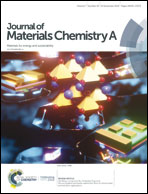How does a small structural change of anode ionomer make a big difference in alkaline membrane fuel cell performance?†
Abstract
Anode ionomers of alkaline membrane fuel cells (AMFCs) play a critical role in hydrogen and water transport thus affecting cell performance and durability. Here, we modified a quaternized poly(biphenyl alkylene) ionomer with two chemical structural variations to increase hydrogen access to the AMFC anode: first, we introduced the symmetric dimethyl groups in the polymer backbone to increase polymer fractional free volume. Second, we replaced hydroxide-conducting alkyl trimethylammonium with alkyl triethylammonium to reduce cation–hydroxide–water co-adsorption on the hydrogen oxidation catalyst to increase hydrogen access to the co-adsorbed layer. We compared the performance benefits of the two structural variations through operating AMFCs under H2/O2 conditions. The membrane electrode assembly employing the modified poly(biphenyl alkylene) ionomer at the anode exhibited >1500 mW cm−2 peak power density at 80 °C with stable short-term durability (>100 h) under a constant current density of 0.6 A cm−2. This study provides an essential insight into designing anode ionomer of highly performing AMFCs.



 Please wait while we load your content...
Please wait while we load your content...
